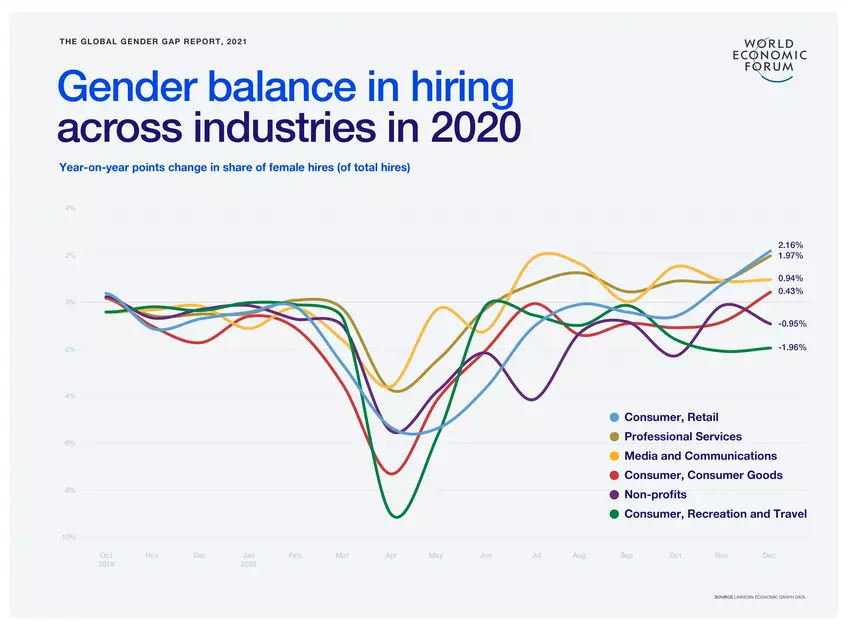Each year since 2006, the World Economic Forum (WEF) has compiled a Global Gender Gap report that measures gender-based gaps among four key dimensions:
- Economic Participation and Opportunity
- Educational Attainment
- Health and Survival
- Political Empowerment
The 2021 report found that on average across the globe, men and women are relatively equal in the dimensions of Educational Attainment and Health and Survival. Political Empowerment is the area where women are worst off, with women representing only 26.1% of the approximately 35,500 parliament seats and just 22.6% of over 3,400 ministers worldwide. However, the Economic Participation and Opportunity dimension is the most relevant one to the adventure travel industry, and women are struggling more than last year, to the point where the WEF estimates it will take almost 270 years to reach gender equality.
Travel Industry Gender Balance Worsened
There has been some marginal improvement in the overall economic gender gap over the previous year. The best-performing countries when it comes to Economic Participation and Opportunity gender equality overall are Lao PDR (with 91.5% of the gender gap closed), Bahamas (85.7%), Burundi (85.5%), Iceland (84.6%), and Latvia (82.2%). Conversely, the countries with the worst Economic Participation and Opportunity gender equality are Afghanistan (with only 18% of the gender gap closed), Iraq (22.8%), Yemen (28.2%), Syria (28.5%), and Pakistan (31.6%).
However, the Recreation and Travel industry fared poorly in this area, with an almost 2% decrease in hiring gender balance, meaning broadly that women working in travel were worse off than a year earlier. It is also important to note that labor force statistics were only available for 2020 for a few countries; the data for others is from 2019. This means that these numbers do not accurately reflect the additional damage COVID-19 has done to the gender gap in the workforce.
According to the WEF and the data available at the time of the report, the hardest-hit industries (Non-profits and Recreation and Travel) are the ones where women are more frequently employed.

Reasons for the Widening Gap
The WEF cites a few issues for the impeded progress in closing the overall Economic Participation and Opportunity gap. One reason is the continual lack of women in leadership positions, as women represent only 27% of all manager positions globally.
Specific to the negative trend in the Recreation and Travel industry, women are being kept out of the labor market at a higher rate than men to assume more responsibility at home due to the COVID-19 pandemic, exacerbating the pre-existing gaps. Because the WEF’s conclusions incorporate pre-COVID data from many countries (as it is the most current information available), the economic gender gap may even be between 1% and 4% wider than reported.
What Does This Mean for Adventure Travel?
As the world continues to recover from the COVID-19 pandemic, women are going to have a difficult time reentering the workforce. Many left their jobs, or reduced their working hours, to care for children during lockdowns and school closures. To address this, the WEF recommends that countries invest in the care sector and equitable care leave for men and women, and that organizations create policies and procedures to proactively focus on overcoming occupational segregation by gender. While these are useful in the big picture and the long term, the adventure travel sector can take more specific actions to have more immediate results.
As tourism recovers, a focus on hiring women should be taken. This is not only for the purpose of evening out numbers, but also to embrace and appreciate the value that women bring to the workforce. Approximately half (51% according to the ATTA’s 2021 Adventure Travel Industry Snapshot Report) of all adventure travelers are women, and female leaders will inherently understand this important segment.
Based on a 2017 research report from the ATTA on Tracking Women’s Leadership in Adventure Travel, leadership in the adventure travel segment is more equitable than in the broader tourism industry. At the time of the research, adventure travel leadership boards were comprised of 38% women, compared to board composition of only 15.8% women in the wider tourism industry.
Despite these findings, female guides and local staff contribute a powerfully unique perspective of the local culture. Many female adventure travelers place a high amount of value on creating a deeper connection with the destination they are visiting, and offering multiple ways of interacting with the local people and culture will result in a more robust tourism product.
What’s Next?
While the ATTA’s 2017 research found the adventure travel segment to be more equitable than the overall tourism industry, many challenges around COVID-19 may have set women back (look for upcoming ATTA research on this topic). However, there is no question that continual effort to close the gender gap is essential. Placing a priority on rehiring women into the adventure travel workforce may mean some additional training or skill refreshers, but it will be worth the time and expense. ATTA also invites anyone interested in this topic to join the Women in Adventure Travel group on LinkedIn (all are welcome).
